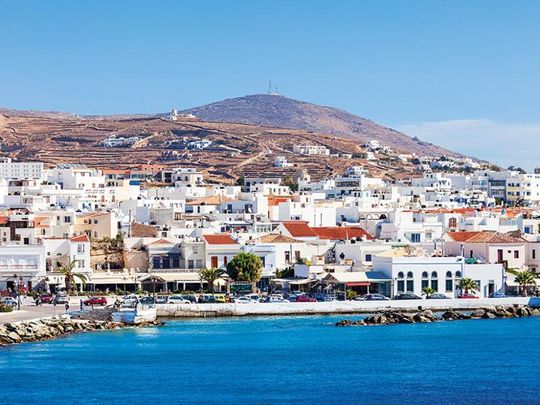
I have something special for you try,” says Tinos local Michalis Kontizas, prising open what looks like a gnarled gourd with a penknife. Inside is a crumbly kariki blue cheese, matured for six months in a pumpkin. Made from raw cow’s milk, it tastes like a mellow Roquefort with the texture of Parmesan. ‘Greece needs tourism, as we don’t produce much. But we want those who come to try the things we do produce,’ he smiles.
Not far from here, Jerome Binda, originally from Paris, has established Domaine de Kalathas where he experiments with natural beverages. A spectacular stone house, decorated with aplomb by Binda’s wife, Sabrina, a ceramic artist who runs workshops in her hilltop atelier, is available to rent (bergerietinos.gr).
Over rabbit stifado, tomato fritters, and pickled artichokes at Tereza’s grocery/taverna in the nearby village of Myrsini, Binda tells me how he left a career as a graphic designer and antiques dealer to settle on Tinos, known since ancient times as the ‘handmade island’.
As with many family-run tavernas in the 50-odd villages of this 75-square-mile isle in the northern Cyclades, pretty much everything on the menu has been grown, reared, foraged or made by Tereza and her husband Joseph.
Restaurants San To Alati, Marathia and Itan Ena Mikro Karavi, all in or near Tinos Town, are all using Greek ingredients in inspired new ways. These and other local food businesses have banded together to create Tinos Food Paths, an annual spring celebration of the island’s culinary heritage. ‘It’s not just cooks and critics, the whole island gets involved,’ says chef Andonis Psaltis. ‘We have barbecues on the beach, masterclasses in monasteries and feasts in village squares with lutes and violins.’
All kinds of businesses have embraced the island’s culinary revival. Eleni Toli (yogaintinos.com), originally from Athens, abandoned a corporate career to set up a yoga shala in an island house built in 1797, and offers hand-picked herbal teas after class. Beekeeper Nikos Karagiorgis sells exquisite heather honey at his shop (tospititoumeliou.com.gr) in Pyrgos.
At Crossroads Inn (crossroadsinn.gr), in Tripotamos, village inhabitants provide ingredients for the Cycladic breakfast – a feast of eggs, preserves, pickles, pies and goat’s cheese.
Also read: Serifos, Greece: great interiors, even better outdoors
Guests at Xinara House (xinarahouse.com) will be able to pick persimmons, peaches and figs for breakfast, to go with eggs, milk and yoghurt from local farmers. The estate has a plunge pool surrounded by colossal boulders and fed by a mountain spring. Village cooks will prepare traditional meals in the kitchen.
But the very essence of Tinos is best tasted at Thalassaki, on the jetty at Ormos Ysternia in the north-west (+30 2283 031366, no website). Antonia Zarpa’s phenomenal food – squid ink tarama, goat’s cheese with bee pollen, and octopus with chickpeas, roast onions and lemon jam – has such a following that speedboats regularly zip over from Mykonos, to the south.
Murmurs of delight punctuate the still evening, until a giant wave appears from nowhere, washing away mussels, flip flops, a phone. ‘This never happens,’ the waiter shrugs.
The next day, as I’m sampling Tinian cheeses at rival taverna Naftilos, another wave lurches over my table. Tinos may be Greece’s new epicurean destination, but it is still, deliciously, at the mercy of the elements.
Traveller’s checks
How to get there: Tinos is 3hr 40mins by ferry from the port of Rafina, a 30-minute drive from Athens airport. Single crossing for a car and two people from €21.50 (Dh98). Check ferries.gr for schedules.
GUARDIAN NEWS & MEDIA LTD, 2018











